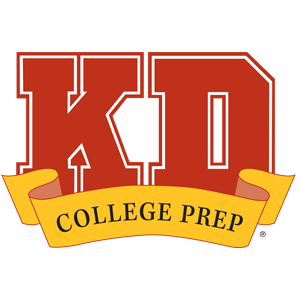College Board announced in early 2022 that it will offer the PSAT/NMSQT® and SAT® tests digitally starting in 2023 and 2024.
The testing organization will administer the first digital PSAT test in October 2023. This will be the first digital test available. However, any national SAT tests or SAT School Day tests administered during a school test day in the fall of 2023 will be on paper.
“Over the last 30 years KD College Prep has seen numerous adjustments, reconstructions, and make-overs by College Board. With each change we have adapted and found new and improved ways to prepare our students,” says David Dillard, CEO of KD College Prep.
This is not the first time that College Board has made significant changes to the tests, and it won’t be the last! However, the shift to an online format will involve some major changes to how the students take the tests and how certain questions are formatted.
In this post, we answer some common questions about what to expect with these changes and provide our advice for families moving forward.
Quick Takeaways About the New Digital Tests:
- College Boards will administer its first national digital test starting with the October 2023 PSAT test.
- Testing time is significantly shorter (2 hours and 14 minutes instead of 3 hours).
- The digital SAT & PSAT tests will now have the same length of time and number of questions.
- The tests will be adaptive, meaning later test questions will change based on a student’s performance in the initial sections.
- The tests will still take place in a proctored, in-person environment.
- Students will take the tests on approved personal and school-issued devices.
- Calculators are now allowed on the entire math section.
- The Class of 2025 will be the first class significantly impacted by these changes.
- Digital piloting for the ACT® test will begin December 2023, but no significant format changes have been announced.
What does “going digital” really mean for the PSAT and SAT tests?
“Digital” can mean a lot of things at first glance. But one thing is clear: students will not take the online PSAT or SAT tests at home.
In their announcement, College Board stated that students will still take the test in person at a school or testing center. The test will continue to be proctored.
Students will take the tests on an approved laptop or similar device through an exam application developed by the College Board. This application will need to be downloaded to the device prior to test day. Be sure to review device specifications and general guidelines available on College Board’s website.
How will the format of the tests change?
As one can imagine, the shift to a shorter, digital test involved a major remodel. Students need to be prepared to encounter new question-types and altered section content.
Overall Format Changes:
The digital test will be unlike anything students have encountered before. Here are some basic, yet significant, format changes that students will need to prepare for:
- The SAT test will last approximately two hours and 14 minutes, which reduces overall testing time by a little less than an hour.
- The new digital format will be adaptive, meaning it will vary from student to student.
- The new digital format will consist of two modules of varying difficulty. After the first module, one of two potential second-stage modules will be administered. The difficulty of module 2 is dependent on module 1 performance.
- On the digital version, questions that test similar skills and knowledge are grouped together and arranged from easiest to hardest.
Reading and Writing Section Changes:
The most significant changes to the new digital version of the tests will be within the reading and writing sections. College Board confirmed that this move to a digital format will change some aspects regarding the content of the test, though the new digital test will continue to evaluate the same core skills of reading comprehension, making inferences, evaluating informational graphics, editing for grammar, and editing text to achieve a rhetorical purpose.
Here are some key differences on the reading/writing sections:
- The digital version of these tests will feature more direct questions and short excerpts instead of full-length reading passages: 25-150 words per passage compared to 350-750 words per passage on the current version, with one question per “passage.”
- Average time per question on the new digital format is 1.19 minutes compared to 1.25 minutes on the current version.
- On the reading section, there will be no more line references on the new digital version. Instead, portions of text are underlined.
- On the reading section of the digital version, “Craft & Structure” makes up 28% of the questions, with “Information and Ideas” accounting for 26% of the questions.
- On the writing section of the new digital test, “Standard English Conventions” accounts for 26% of the questions (compared to 21% on the current version), and “Expression of Ideas” 20% (compared to 25% on the current version).
Math Section Changes
College Board has also announced the following changes to the math sections when it shifts to the digital format:
- Students can use calculators on every math question of the new digital test. Students can bring their own calculator or use the calculator built into the exam application.
- Average time per question is 1.6 minutes on the new digital format, compared to 1.25 minutes (no calculator) and 1.45 minutes (with calculator) on the paper version.
- The new digital test will contain shorter word problems—generally 50 words or less.
- “Grid-ins” are now called “free response.”
- There appears to be a slight increase in the number of more difficult math questions, but the same four concepts are tested: Algebra I and II, geometry, and trigonometry.
Digital Test Timeline
While digital testing has been available in smaller capacities for several years, the College Board’s pivot to digital testing is significant. Below we provide a quick timeline of test changes and what to expect in the coming months.
- November 2021: College Board pilots the digital SAT test in the U.S. and internationally
- January 2022: College Board announces its plans to shift to digital testing
- March 2023: International SAT tests offered digitally for the first time
- May 2023: KD College Prep announces the launch of new digital practice tests for the PSAT and SAT tests
- May 30, 2023: ACT, Inc. announces its plan to launch a digital test pilot in December 2023
- October 2023: U.S. high schools administer the first national PSAT/NMSQT and PSAT 8/9 tests
- March 9, 2024: U.S. students will take SAT test for the first time digitally
College Board has opened registration for Spring 2023 test dates.
Recommendations By Grade Level
Whether these changes apply to you varies depending on your grade level. Below we provide more specific guidelines for each group of current high school students.
Class of 2024
For U.S. students, these changes will only affect Class of 2024 high school students who decide to take the test during the spring of their 12th grade year. As mentioned above, College Board will offer the first digital SAT test in the U.S. during the spring of 2024.
Class of 2025
These students will experience both paper and digital tests. This past fall (fall of 2022), 10th graders in the Class of 2025 took a paper PSAT test. In 11th grade, they will take the digital PSAT test. It’s important to note here that College Board has indicated that instead of a handful of in-school test dates for the PSAT digital test in the fall of 2023, schools may decide on a test date any time during the month of October. Check with your high school counselor to know exactly which day you can expect to take the test.
For SAT tests taken through December of the 11th grade, these students will take the paper version. Starting in spring of 11th grade, they will take the new digital SAT® test.
We recommend that these students continue preparing as normal. As College Board announces additional details regarding these changes, we will communicate more specific recommendations. At KD, we will include preparation for both the paper and digital format for these students.
We strongly encourage students to complete testing prior to 12th grade to allow for more time to focus on college applications.
Class of 2026 and Younger Students
The Class of 2026 will be the first impacted by a purely digital testing environment for the PSAT and SAT tests. Since the test content will remain consistent, students still need to acquire and practice math and verbal skills. You should continue your foundational preparation with KD as recommended. We will communicate more specific changes in spring of 2023.
Please Note: Some high-level Class of 2026 students should consider taking the paper SAT test at some point before December of 2023 of their 10th grade year. Please speak to a KD advisor to see if this recommendation might apply to your student.
Device Specifications
Students will need to follow College Board’s instructions on what to bring on test day. It’s also important to check with the high school to see if students should bring their own device or if one will be provided for them. If a student needs to borrow a device on test day, he or she must make a request to College Board at least 30 days before test day.
For the October 2023 digital PSAT test, students may take the test on one of the following:
- Windows laptop, tablet, or desktop
- Mac laptop
- iPad
- School-managed Chromebook
Please note: Personal Chromebooks are not permitted. Please note that device specifications are subject to change, so check College Board’s website for the most up-to-date information.
How will KD address these changes?
At KD College Prep, we have anticipated this change and adjusted our offerings so that we could continue to offer expert assistance to students impacted by this change.
Prep activities and practice exams for the new digital test are now available to KD students.
Will a paper test still be available?
College Board has stated that digital testing will replace the paper materials and pencils currently required. A paper PSAT test will not be available starting in the fall of 2023, and a paper SAT test will not be available starting in the spring of 2024. However, students have the option to bring their own pencils to use on scratch paper provided on test day.
How will these changes affect students who have existing accommodations?
College Board states they will continue to ensure every student has the appropriate accommodations they need and that most paper-test accommodations will transfer directly to the digital test. Students unable to test digitally will have an avenue to request a paper test.
What should students do now before the format changes?
Take advantage of test prep courses and digital practice tests designed to help prepare you for these major test changes. If you are a current KD student, make sure you’re reviewing the specific recommendations related to the digital test.
Before test day, review the device specifications and guidelines provided by the College Board. We also recommend that students bring a calculator that they already know how to use. Continue to prepare and let us help you with specific recommendations for you and your testing goals.
Will the ACT test also go digital?
The ACT test announced back in September 2019 that it was planning to offer online options to students starting in the fall of 2020. The pandemic altered those plans, and the ACT test announced in July 2020 that its online testing plans had been postponed.
In May 2023, the ACT test announced plans to pilot a digital test offering in December 2023. However, it appears that the format will remain the same in terms of number of questions and length. It is not yet clear what other changes will come after the initial pilot.
Need help preparing for the new digital tests?
Our advisors are available to answer questions regarding these test changes and can provide direction on the best next steps for your family. For more guidance, schedule a free consultation or contact your home campus.
“As always, we are here to make sure our students are ready to show their best selves when it matters most,” Dillard says.














































